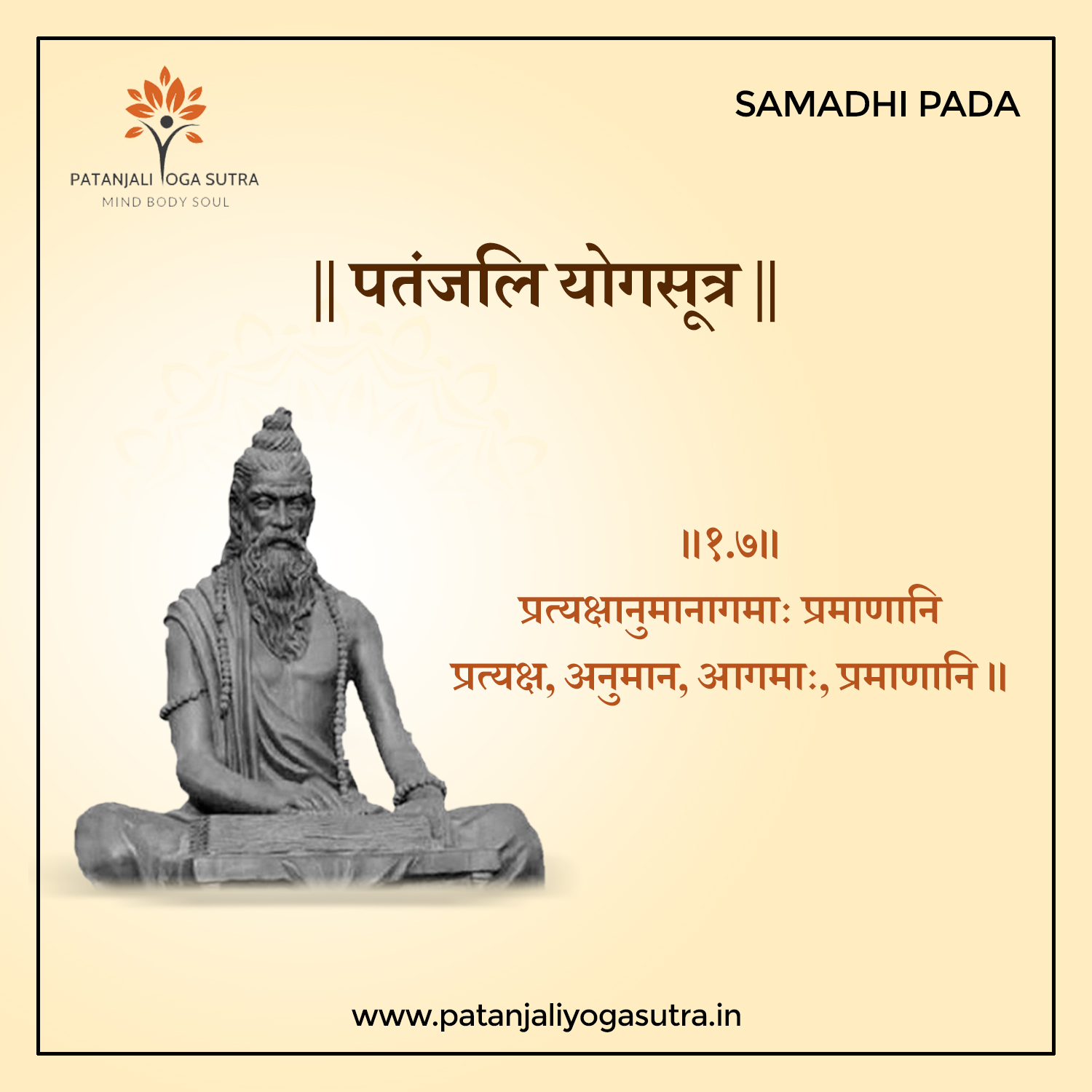



योगदर्शन में प्रमाण के तीन प्रकार कहे गए हैं।
जिस साधन या उपाय के माध्यम से किसी भी वस्तु के स्वरूप, एवं स्थिति की स्पष्टता का ठीक ठीक ज्ञान होता है उसे प्रमाण कहते हैं। महर्षि पतंजलि ने 5 वृत्तियों में सबसे पहले प्रमाण को ही वृत्ति कहा है।
ये पांच वृत्तियों का एक क्रम है।
यथार्त ज्ञान (प्रमाण-प्रत्यक्ष,अनुमान और आगम) से प्रांरम्भ होकर गलत, मिथ्या या उल्टा ज्ञान (विपर्यय) फिर केवल आभासी ज्ञान, बनावटी ज्ञान जो केवल शब्दों तक सीमित है वास्तव में उसका कोई अस्तित्व नहीं है (विकल्प) और सब प्रकार के ज्ञान जो जाग्रत एवं स्वप्न में होते हैं उस ज्ञान का अभाव होने पर भी जो एक नई अनुभूति होती है (निद्रा) और अंत में पूर्व में अनुभव किये गए विषयों (देखे गए, सुने गए, समझे गए, स्वाद लिए गए, बोले गए, किये गए, स्पर्श किये गए एवं गंध महसूस किए गए) का फिर से स्मरण (स्मृति) यह वृत्ति का एक विशेष क्रम है जिसमें से साधक को दुख देने वाली (क्लिष्ट) वृत्तियों को रोकने का निरंतर अभ्यास एवं वैराग्यपूर्वक विशेष प्रयत्न करना ही होता है।
अब आईये सबसे पहले समझते हैं प्रत्यक्ष प्रमाण को।
अतः प्रत्यक्ष का अर्थ हुआ “आंख के सामने”। आंख से यहां पर सभी ज्ञानेद्रियों को कहा गया है। प्रत्यक्ष का बड़ा अर्थ हुआ कि जो ज्ञान 5 ज्ञानेन्द्रियों का विषय (रूप,रस,गंध,स्पर्श और श्रवण) से सीधा संपर्क होने पर होता है उसे प्रत्यक्ष प्रमाण कहते हैं। यह वृत्ति भी दुख देने वाली और सुख देने वाली हो सकती है अर्थात योग मार्ग में ले जाने वाली और योग मार्ग से विमुख करने वाली हो सकती है। इसलिए साधक को चाहिए कि विवेकपूर्वक भेद करके उन्हीं प्रत्यक्ष प्रमाण को जीवन में स्थान दें जो एकाग्र या निरुद्ध अवस्था में उसे लेकर जाएं जहां से वह समाधि की अवस्था को पाया जा सके।
अब प्रश्न यह उठता है कि कैसे पता चले कि कौन सी प्रमाण अंतर्गत प्रत्यक्ष वृत्ति क्लिष्ट है और कौन अक्लिष्ट!!
इस जगत में शुभ भी प्रत्यक्षपूर्वक परिदृष्ट होता है और अशुभ भी। शुभ का प्रत्यक्ष होना चित्त को शांत और आनंदित करता है अर्थात एकाग्रता की ओर ले जाता है वहीं दूसरी ओर अशुभ का प्रत्यक्ष होना चित्त को बाहर और भीतर से अशांत और क्षोभित करता है अर्थात चित्त को चंचलता की ओर ले जाता है। ये एक ही प्रत्यक्ष अक्लिष्ट और क्लिष्ट भेद से सुख और दुख देने वाले हो जाते हैं।
अक्लिष्ट प्रत्यक्ष= किसी को सेवा करते देखना, भगवतनाम का संगीत सुनना, जिससे तन-मन प्रफुल्लित हो ऐसी सुगंध सूंघना, तन और मन दोनों हृष्ट पुष्ट हों ऐसा भोजन का स्वाद लेना आदि|
क्लिष्ट प्रत्यक्ष= किसी होती हुई हिंसा को देखना, अश्लील दृश्य देखना, अश्लील और भड़काऊ संगीत सुनना, तामसिक गंध सूंघना, अभक्ष्य भोजन जैसे मांस, मदिरा आदि खाने का स्वाद लेना यह सब क्लिष्ट प्रत्यक्ष वृत्ति है और दुख देने वाली है|
In Yoga Darshana the right knowledge (Parmanas) is of three types:
Pramana is the tool or the medium through which the knowledge of clarity about the natural form or condition of an object is gained. Out of the five vritties Maharshi Patanjali has called Parmana as the first vritti. This is a cycle of five vritties:
Accurate knowledge (Parmana-Pratyaksh, Anumaan, and Aagamah) starts from wrong, false or mithya knowledgeand then only aabhasi (virtual) knowledge, spurious knowledge which is limited to words only and does not exist in reality (Vikalpa). The feeling even in the absence of all types of knowledge that is gained in wakeful condition or in dreams is nidra and finally the memory (smriti) of the past experiences (seen, heard, understood, tasted, spoken, done, touched or smelt). This is a special arrangement of vritti in which the continuous practice or vairagyapurna (anchoretic) special attempt has to be made to stop the vritties that cause pain to the practitioner (klishta).
Now let us first understand direct proof. Prati + aksha= Pratyaksha
Prati means ‘in front’ and Aksha means ‘Eye’.
Therefore, Pratyaksha means ‘in front of eye’. Eye here refers to all senses. So Pratyaksha means the knowledge gained through direct contact of the object with any of the five senses (beauty, taste, smell, touch and hearing). This is called Pratyaksha Pramana. This vritti can be pleasant as well as unpleasant i.e. it can take you on the path of Yoga or away from it. So the practitioner should intelligently differentiate to include only those Pratyaksha Pramana in life which eventually helps him to attain the state of Samadhi (absorption) through ekagra or nirudha.
Now the question is how to find out which Pratyaksha vritti under which Pramana is Kalisht (unpleasant) or Akalisht (pleasant).
Pleasant and unpleasant both are clearly visible in this world. Shubha (pleasant) by being visible pacifies and makes the mind happy that is it takes the mind towards ekagrata (concentration). On the other hand visible unpleasant disturbs and upsets the mind externally and internally. It distracts the mind. It is pleasant and unpleasant vritti at the same time.
pratyaksha is to see someone serve others, to hear bhagvatnama music, to smell aroma which makes you ecstatic, to eat food that makes both your body and heart happy etc.
Kalisht pratyaksha – To witness some violent incident, to watch porn scene, to listen to provocative music, smell aroma, to savour non-vegetarian food are all pain causing kalisht pratyaksha vritti.
सूत्र: प्रत्यक्षानुमानागमाः प्रमाणानि
हमको ज्ञान कैसे होता, महर्षि इस सूत्र से समझाते
प्रत्यक्ष, अनुमान और शब्द ये तीन प्रमाण हैं बतलाते ।
A humble request for this amazing interpretation of Yog Sutras to be published in the form.of a book.
That’s great idea.. thanks for your insights
You didn’t describe the rest two pramana:
Anumaan and Aagamah
Please solve it!
Which Audio
Is there No audio explanation for this and upcoming sutras?
unable to access the explanation audio. Kindly inspect.
Explanation audios are not playing 1.7 onwards.
We are uploading soon
“Accurate knowledge (Parmana-Pratyaksh, Anumaan, and Aagamah) starts from ”
There is a mistake in this line of the commentary. It should have been : ” It starts with Accurate knowledge “